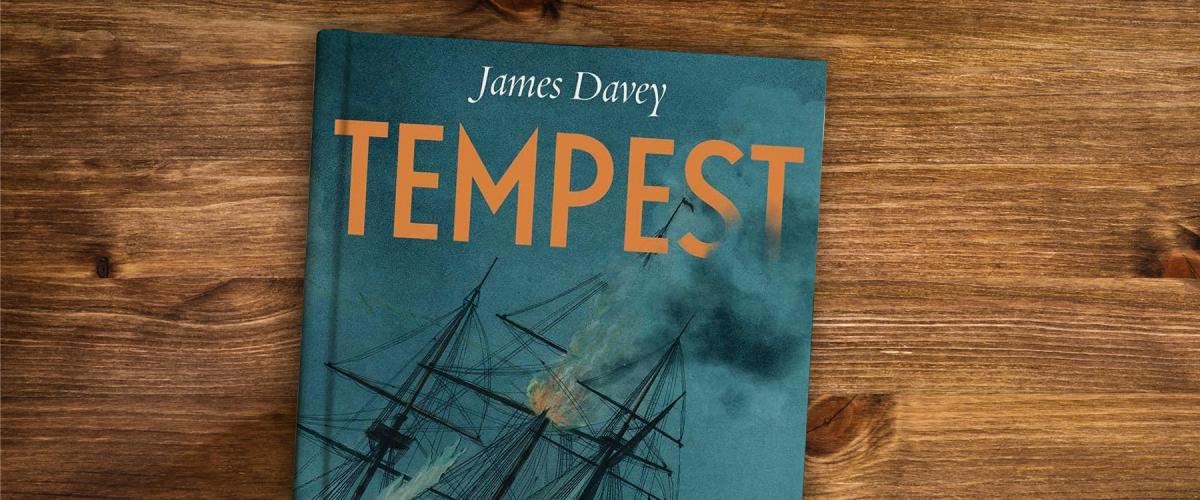Tempest: The Royal Navy and the Age of Revolutions
James Davey. New Haven, CT: Yale University Press, 2023. 448 pp. Illus. Maps. Notes. Biblio. Index. $35.
Reviewed by Frederick C. Leiner
James Davey, a lecturer in naval history at the University of Exeter in England and author of several highly regarded books on the Royal Navy during the Age of Sail, is one of the leading practitioners of “new naval history.” That term designates an interdisciplinary approach, examining not “traditional” notions of battles and strategy, but rather using naval history as a prism though which to examine issues such as cultural life, imperialism, and the texture of shipboard life. In Tempest: The Royal Navy and the Age of Revolutions, Davey focuses on the Royal Navy during the 1790s, a decade of revolutionary upheaval and ideas that permeated the navy, causing a lengthy crisis in order and discipline.
Tempest is therefore not a “battle” book, although the fleet actions on the Glorious First of June (1794) and at Cape St. Vincent (1797), Camperdown (1797), Aboukir Bay (1798), and Copenhagen (1800) are discussed relatively briefly. Instead, in wonderfully wrought detail, Davey looks at what loosely may be called the morale of the British fleet, affected by the French Revolution’s ideals of liberté, égalité, and fraternité, and the fervent republican feeling boiling up in Ireland (although Davey downplays ethnic considerations, a large percentage of sailors were Irish). At the same time, he examines the feelings of the British public about the navy.
Throughout the decade, the Royal Navy experienced repeated mutinies in fleets and on board single ships, many about “working conditions” and pay (which had not been raised in a century), but, over time, some with more radical aims. The mutinies are the focal point of Tempest. Though the more radical sailors’ actions were crushed by the government of Prime Minister William Pitt, the great fleet mutiny at Spithead, which sought pragmatic gains, albeit using radical language of “natural rights” borrowed from thinkers such as Thomas Paine, won major reforms. Yet, the mutinies caused estrangement between the public and the navy. At the same time, Davey demonstrates, the British people realized the vaunted “wooden walls” of the navy had not really protected them from repeated French sorties to invade Ireland (which were defeated largely by the weather and logistical problems), and the French and their revolutionary ideas continually threatened Britain over the decade.
Davey explains that repressive legislation put through Parliament in 1795 to stifle dissent and sedition caused the Admiralty to direct a tightening of discipline in the fleet, punishing complainants with floggings. Many sailors thought the stifling of their legitimate complaints breached the implicit social contract they had as Englishmen to seek the redress of their grievances. Repression and floggings led to increased tensions, and then to mutiny.
One of the great achievements of Tempest is to treat the sailors not as some undifferentiated mass but as people with individual opinions. Some sailors were radical, others reformist, others noncommittal, and still others were loyal to the status quo. In promulgating demands, each mutinous ship had to navigate the opinions of her crew. Davey recaptures the voices of sailors through meticulous research in court-martial records, diaries, and letters. Similarly, he portrays the changing attitudes of the public toward the navy by an impressive and wide examination of newspapers in London and the provinces, ballads, theater productions, pamphlets, and cartoons.
Davey shows the British public’s resistance to impressment, not just by hapless individuals caught up in the “press,” but by whole towns, using legal means and mob action. Indeed, even as impressment brought manpower into the navy, there was a constant drain of sailors from desertion and mortality, yet somehow, ships got manned and crews got trained to reef and steer and handle the guns.
To help repair the tarnished image of Jack Tar, the British government and press lionized a common sailor, Jack Crawford, for his heroic action at Camperdown (nailing the fallen colors to the mast of Admiral Adam Duncan’s flagship, after they had been shot away). Then, Pitt and the newspapers found a new hero for the public in the form of Admiral Horatio Nelson, and the rest, as they say, is history.
With its emphasis on morale, both of sailors and of society, Tempest may not be the best introduction to the Royal Navy during the French Revolutionary Wars. But with its rich detail about how radical ideas infiltrated the navy, and how the government and society responded to the sailors’ demands and mutinies, Tempest is a welcome addition to the historical literature. Tempest is impressive, deeply researched, and well written, and scholars and serious students of British naval history will find much to appreciate within its pages about an era of crisis in the Royal Navy.
Mr. Leiner, a lawyer, is a regular contributor to Naval History about the Navy in the Age of Sail. His most recent book is Prisoners of the Bashaw: The Nineteen-Month Captivity of American Sailors in Tripoli, 1803–1805 (Westholme, 2022).
Combat In the Sky: Airpower and the Defense of North Vietnam, 1965–1973
Đồng Sỹ Hưng. Annapolis, MD: Naval Institute Press, 2023. 408 pp. Appx. Gloss. Notes. Biblio. Index. $35.97.
Reviewed by Barrett Tillman
The Vietnam War is over.
But for history, that declaration has little to do with diplomatic relations between the United States and Vietnam. Nor does it reflect the lifelong bitterness of many American veterans toward those who directed “that crazy Asian war.”
However, when former enemies cross-reference each other’s combat records comparing names, dates, and places, the necessary cooperation requires peaceful accord.
Cockpit-to-cockpit matchups have long been a popular feature of aviation history. In the 1990s, Britain’s Grub Street published a series allowing researchers to compare dogfight participants with reasonable accuracy.
The Naval Institute Press published John B. Lundstrom’s encyclopedic two-volume history, The First Team, in 1984 and 1994, detailing Navy fighter combat through Midway and near the end of 1942, respectively. U.S. and Japanese aircrews are routinely identified in specific actions.
In addition, some Korean War historians with access to Soviet records have placed opposing pilots in the same airspace in MiG Alley.
Therefore, the emerging depth of material detailing North Vietnam’s air operations from 1965 to 1973 seemed ready-made for evaluation. The Naval Institute Press contracted with the People’s Army Publishing House to produce an English-language edition of the 2013 Air Engagements in the Sky over Vietnam as Viewed from Both Sides.
The volume is compiled by an extremely well qualified author-editor. Đồng Sỹ Hưng is a former MiG pilot fluent in English with a doctorate from Moscow Military Science Academy. He held senior positions in Vietnamese military and civil aviation and worked with U.S. and Vietnamese linguists.
U.S. aircrews claimed 197 victories during the war, and among the book’s appendices is a list of 83 claims unverified in the Vietnamese People’s Air Force (VNPAF) claimed losses, an excess of 43 percent. Actually, that figure matches some historic averages.
As much as analysts enjoy playing “the numbers game” with air-to-air results, most concede that there are too many variables for definitive answers. Over North Vietnam, antiaircraft artillery and surface-to-air missiles sometimes overlapped fighter claims on both sides. Therefore, some specific loss causes may never be known.
Moreover, both sides acknowledged air-to-air losses with no opposing claim, and the text omits some clashes, including a USS Midway (CVA-41) F-4 crew’s last victory of the war in January 1973.
With varying sources, the author hints that the VNPAF lost 125 jets to U.S. pilots versus about 90 American planes downed by MiGs.
Two missions are examined in particular. The U.S. Air Force’s Operation Bolo in January 1967 claimed seven MiG-21s, versus five admitted by the VNPAF.
One of the biggest combat actions of the war was fought on 10 May 1972 between Navy F-4s and MiG-17s. Total Navy claims of seven compare to three contained in VNPAF losses.
The text briefly covers B-52s and drones (the VNPAF credited drones the same as manned aircraft). Other portions address organization, evolution of tactics, and, for Institute readers, a brief section on MiG attacks against U.S. Navy ships.
A photo section includes 25 good-quality black-and-white images.
Combat in the Sky is certain to become a standard reference.
Mr. Tillman is a seven-time Institute author, life member, and recipient of two Naval Institute writing awards.






